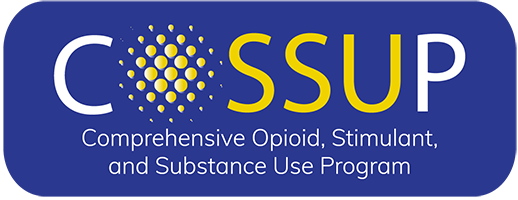About the Program
The Comprehensive Opioid, Stimulant, and Substance Use Program (COSSUP), formerly the Comprehensive Opioid Abuse Program (COAP), was developed as part of the Comprehensive Addiction and Recovery Act (CARA) legislation.
COSSUP’s purpose is to provide financial and technical assistance to states, units of local government, and Indian tribal governments to develop, implement, or expand comprehensive efforts to identify, respond to, treat, and support those impacted by illicit opioids, stimulants and other drugs.
While the opioid epidemic has dominated headlines, communities throughout the nation have been impacted by diverse drug use patterns including stimulants and other illicit substances. Our nation’s substance use problem is a public health emergency that threatens the wellbeing of individuals who use drugs and impacts the safety of communities. It is impacting first responders, the criminal justice system, child welfare and foster care, and behavioral health systems. Responding to this health emergency is one of the Department of Justice's top priorities.
The cornerstone of COSSUP is its emphasis on partnership and collaboration across the public health, behavioral health, and public safety sectors. Effective community responses leverage the combined expertise of each of these disciplines and rely upon unified and coordinated strategies.
COSSUP is committed to supporting four key areas of programmatic focus:
- Promoting public safety and supporting access to treatment and recovery services in the criminal justice system.
- Strengthening the collection and sharing of data across systems to understand and address the impact of illicit substance use and misuse.
- Align and maximize resources across systems and leverage diverse program funding.
- Prevent illicit substance use and misuse.
See the Success Spotlight page to learn how COSSUP funds are impacting grant recipients and the communities they serve.
Site-Based Grants
Site-based grants are released annually and provide funding opportunities for both states and territories as well as local and tribal communities. COSSUP funding is designed to be flexible, allowing each community to address its unique needs and respond to emerging threats that may be local or regional in nature.
Demonstration Projects
In FY 2018, BJA and various partners launched demonstration projects that strategically blend funding from multiple federal agencies and promote public-philanthropic partnerships. These demonstration projects strengthen our understanding of effective community responses to illicit substance use and misuse, expand adoption of effective practices and support innovation, and build capacity in those communities most impacted by substance use disorder.
- National Initiative to Expand Opioid Use Disorder Treatment in Jails: Building Bridges Between Jails and Community-Based Treatment
- Overdose Detection and Mapping Application Program (ODMAP) Statewide Expansion and Response
- Partnerships to Support Data-driven Responses to Emerging Drug Threats
- Rural Responses to the Opioid Epidemic
Training and Technical Assistance
The COSSUP TTA Program supports communities by:
- Facilitating peer-to-peer learning opportunities in which communities can learn from experienced programs through virtual consultations and on-site visits.
- Providing speakers for conferences and workshops or skilled subject-matter experts for training events to educate stakeholders and build capacity.
- Facilitating strategic and cross-system planning to identify community resources, establish priorities, and develop a road map to achieving goals.
- Identifying materials such as policies and procedures, guidelines, and data sharing agreements that support program activities.
- Supporting PDMPs by increasing PDMP efficiencies and facilitating coordination between PDMPs and state and national stakeholders.
Funding
View the Funding page to learn about current and past opportunities available through this program. The resources provided are offered to assist potential applicants in applying for future COSSUP funding. Please refer to the grant's funding opportunity announcement for specific details regarding eligibility, content and formatting requirements, submission instructions, required supporting documentation, and more.
In the past 4 years, BJA has funded over 500 COAP/COSSAP projects. The types of activities funded under the grant program, in past opportunities, includes:
- Establish pre-arrest or post-arrest law enforcement or other first-responder diversion programs for individuals who commit low level, non-violent, drug-related offenses to community-based substance use and misuse and behavioral health services.
- Support law enforcement agencies in identifying individuals in need of substance use and misuse treatment services and connecting these individuals to treatment services.
- Develop programs that embed social services with law enforcement in order to rapidly respond to opioid overdoses where children are impacted.
- Connect individuals at risk for overdose and/or survivors of a non-fatal overdose and their families with substance use disorder and behavioral health treatment providers or peer recovery support providers trained in addiction support and recovery.
- Provide transitional or recovery housing as part of a comprehensive response strategy.
- Establish court-based intervention programs or family court programming to prioritize and expedite treatment and recovery services to individuals at high risk for overdose.
- Develop, implement, or enhance programs to address the opioid epidemic in rural or tribal communities.
- Purchase and distribute tamper-proof drug-collection boxes and other federally approved controlled substance collection and permanent disposal programs.
- Develop and implement a comprehensive plan to reduce the risk of overdose death and enhance treatment and recovery service engagement among the pretrial and post-trial populations leaving jails or secure residential treatment facilities.
- Implement an overdose fatality review team (that includes representation from medical examiner or coroner offices) and/or support multidisciplinary intervention models to bring together stakeholders with different perspectives and different data sets.
- Support the timely collection of data and/or data integration with other data sets to provide an understanding of drug trends, support program evaluation, inform clinical decision making, identify at-risk individuals or populations, or support investigations.
- Implement other comprehensive approaches that align with program objectives.
See the Applying for Funding section of the COSSUP website for additional details.
Examples of Successful Applications from Past Years
These samples are project narratives from previously funded projects. They are provided for reference to assist in preparation of a funding application.
- Cook County Health
- Cook Inlet Tribal Council, Inc.
- Opioid Overdose Community Outreach Enhancement
- PDMP
- Tribal Law Enforcement Assisted Diversion
- Turtle Mountain Band of Chippewa Indians
- Collaborate Multistate Response
- Teleservices
- Peer Recovery, Overdose Response Team, Law Enforcement/First Responder Diversion, and Court Diversion
- Technology-Assisted Treatment



